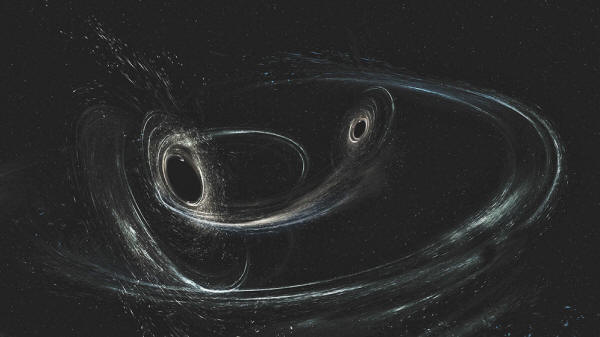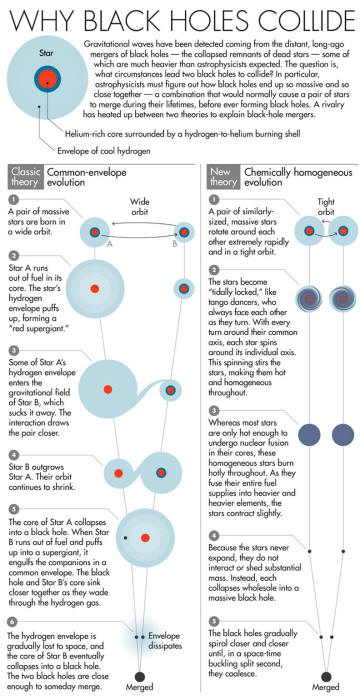|
by Natalie Wolchover
from
QuantaMagazine
Website whose gravitational-wave signal suggests that at least one of the black holes was misaligned
with
its orbital motion before merging with its partner.
(Aurore
Simonnet) third detection further compounds the mystery of why black holes collide.
The new signal, detected in January and reported today (GW170104 - Observation of a 50-Solar-Mass Binary Black Hole Coalescence at Redshift 0.2) in Physical Review Letters, deepens the riddle of how black holes come to collide.
Before Advanced LIGO switched on in the fall of 2015 and almost immediately detected gravitational waves from a black-hole merger, no one knew whether it would see merging black holes, merging neutron stars, black holes merging with neutron stars or none of the above.
(As Albert Einstein figured out a century ago, pairs of dense, tightly orbiting objects are needed to generate ripples in the fabric of space-time, or gravitational waves.)
But the three signals spotted by LIGO so far have all come from merging black holes, suggesting pairs of these ultradense, invisible objects abundantly populate the universe.
Astronomers have since been struggling mightily to understand how black holes (which, for the most part, are remnants of collapsed stars) can wind up so close to each other, without having been close enough to have merged during their stellar lifetimes.
It's a puzzle that has forced experts to think anew about many aspects of stars.
They'll now have to think even harder.
for Quanta Magazine
The LIGO team's estimate for the abundance of black-hole mergers in the universe, based on its first two detections, favored one of two competing scenarios for how stars might end up colliding as black holes:
The methods differ in their details, but either is theoretically capable of producing enough black-hole mergers to account for Advanced LIGO's signals.
Scientists think it's likely that one scenario is dominant in the universe and accounts for almost all observed events, since it would be strange for multiple scenarios to produce equal numbers of events in a fine-tuned balance.
Meanwhile, the high rate of mergers disfavored a third scenario called "dynamical formation," which has the black holes forming far apart inside a dense stellar cluster.
According to this theory, over time, the black holes sink to the center of the cluster, perturbing one another's orbits in complicated ways and, occasionally, entering tight enough orbits to collide.
Considering the relative rareness of stellar clusters and dynamical collisions, the expected rate associated with this scenario seemed too low to account for Advanced LIGO's data.
That's where the new gravitational-wave signal comes in.
It originated from black holes weighing 31 times and 19 times the mass of the sun that merged roughly 3 billion light-years away.
The signal also indicates that at least one of the black holes may have been spinning in a direction that was not aligned with the pair's common axis of rotation.
Black holes that formed and evolved from a close-knit pair of stars - as in the common-envelope and chemically homogeneous scenarios - would spin in the same direction as their common axis (if at all), so misaligned spins would disfavor these scenarios and favor dynamical formation in a stellar cluster, which does not require any connection between the black holes' spins.
The spin measurement is difficult to do and carries some uncertainty - it's within the margin of error that the black holes weren't spinning at all.
Duncan Brown, a LIGO member and professor of physics at Syracuse University, told Quanta that it might be possible after all that multiple scenarios produce black-hole mergers.
But he's waiting for more statistics.
|



